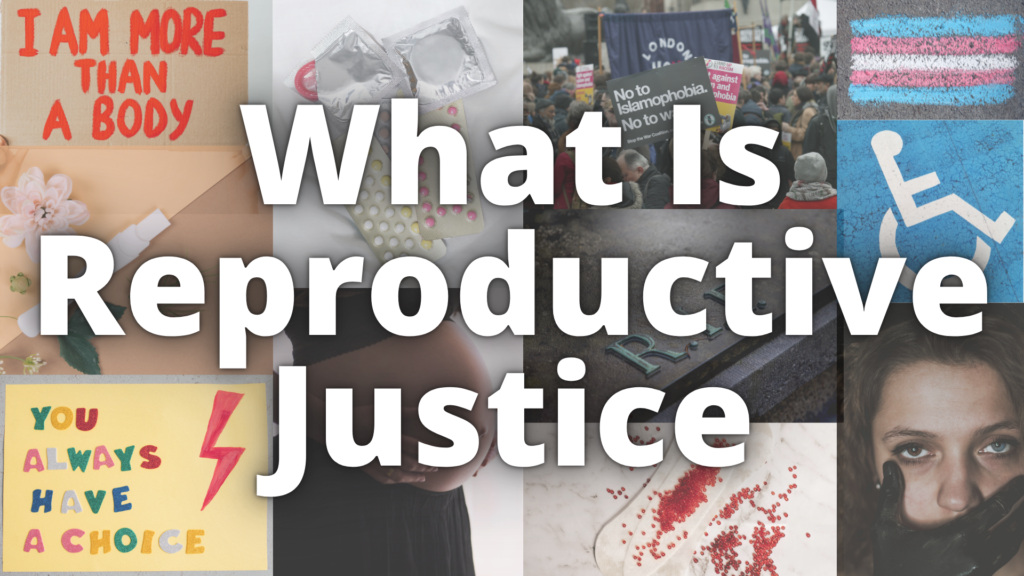
What is reproductive justice you say? If you’ve been on the Internet for the past few years, you’ve noticed that people like to “discover” things that have existed for decades. Avocado, sarees, online sex work, violence against women and non-binary people, racism.
And now, many places have added reproductive justice to their buzzwords to make them seem less complicit in exploiting women of color.
But, what is repro justice? Seriously, what do YOU know about reproductive justice? Do you know its history? Do you know how it was formed? What does it stand for? Let’s dive into the history of this term, my views on reproductive justice, and learning more about it.
What Is Reproductive Justice?
To begin with, something super important to note is that Indigenous women, poor women, women with disabilities, Black women, immigrant women, non-Black women of color, trans people, non-binary people, and people on the margins have always fought for reproductive justice.
The story of reproductive justice (or repro justice for short) began in Chicago, Illinois in June 1994. A group of Black women met right before going to the International Conference on Population and Development in Cairo, Egypt. Black women met to discuss their needs and concerns often un-addressed and dismissed by mainstream white feminist organizations.
This group of Black women recognized that visible women’s rights movements in America were often funded and led by financially privileged white women.
Often times, white feminist organizations excluded the needs of women of color, trans people, poor people, and so on. So, Black women from this encounter crafted their own vision. Black women realized that a movement needed to truly recognize the most socially marginalized, historically disenfranchised, and systemically excluded populations.
These women called their group The Women of African Descent for Reproductive Justice. The term reproductive justice came to life and was presented internationally at the conference in Cairo. Also, the repro justice framework is rooted in the United Nations’ human rights framework and combines social justice and reproductive rights.
Because mainstream social justice movements and reproductive rights movements did not (and still struggle with) intersecting the two.
The creators of repro justice launched the movement by publishing a historic full-page statement with 800+ signatures in The Washington Post and Roll Call. In 1997, SisterSong Women of Color Reproductive Justice Collective emerged and created a national, multi-ethnic RJ movement. Presently, SisterSong is a non-profit focusing on redefining what is reproductive justice, doing advocacy, and and educating on repro justice.

More on Reproductive Justice
Reproductive justice is a critical, theoretical framework that was invented as a response to United States reproductive politics. The three core values of reproductive justice are the right to have a child, the right to not have a child, and the right to parent a child or children in safe and healthy environments. The framework moves reproductive rights past a political debate to incorporate the economic, social, and health factors that impact people’s reproductive choices and decision-making ability.
When defining reproductive justice, people often reference the concept intersectionality, a broader framework used to analyze the various life experiences individuals may have as a result of the ways in which their identity categories, such as race, class, gender, and sexuality, interact with each other.
Loretta Ross, co-founder of the SisterSong from 2005 to 2012, defines reproductive justice as a framework created by activist women of color to address how race, gender, class, ability, nationality, and sexuality intersect.
Why I Love Repro Justice
I fell into the world of all things reproductive justice by total accident. I had no idea about repro justice, social activism, or anything like that growing up. Honestly, I never learned about it in school, and I never saw anything like it on the Internet. But, when I started doing my own reading and research on what is reproductive justice, from poor women undergoing forced/coerced sterilization to immigrant women not having access to domestic violence resources, it hit me.
Finally, I understood why reproductive justice came to life. I look at feminist movements a decade ago, and they were so white and only focused on abortion. Things are never just pro-choice or not. It’s about access to contraception, access to health care services without delaying it because of cost, access to a non-racist health care provider, access to contraception without pressure to choose a certain option. When thinking about repro justice, think about the politics of choice, decision, and options.
In addition, for more readings and history on reproductive justice, check out some personal favorites!
Reading List
- Colonize This! Young Women of Color on Today’s Feminism – Daisy Hernandez, Bushra Rehman, Cherrie Moraga
- Feminism Without Borders: Decolonizing Theory, Practicing Solidarity – Chandra Mohanty
- The Color of Violence: The Incite! Anthology – INCITE! Women of Color Against Violence
- The Sexual History of the Global South: Sexual Politics in Africa, Asia, and Latin America – Saskia Wieringa and Horacio Sivori
- The Bridge Called My Back: Writings by Radical Women of Color – Cherrie Moraga & Gloria Anzaldua
- Radical Reproductive Justice: Foundation, Theory, Practice, Critique – Loretta Ross and Erika Derkas
- Dragon Ladies: Asian American Feminists Breathe Fire – Sonia Shah, Yuri Kochiyama, Karin Aguilar-San Juan
- Making Waves: An Anthology of Writings by and about Asian American Women – Asian Women United of California
- Making More Waves: New Writing by Asian American Women – Elaine Kim, Lilia Villanueva
- Sexing the Caribbean: Gender, Race and Sexual Labor – Kamala Kempadoo
- The Comfort Women: Sexual Violence and Postcolonial Memory in Korea and Japan (Worlds of Desire: The Chicago Series on Sexuality, Gender, and Culture) – C. Sarah Soh
- Trauma: A Collection of Short Stories – Elizabeth Jaikaran
- YELL-Oh Girls! Emerging Voices Explore Culture, Identity, and Growing Up Asian American – Vickie Nam
- Her Name Is Kaur: Sikh American Women Write about Love, Courage, and Faith – Meeta Kaur
- Our Feet Walk the Sky: Women of the South Asian Diaspora – Sheela Bhatt, Pretty Kalra & Aarti Kohli
- Claiming Place: On the Agency of Hmong Women – Chia Youyee Vang, Faith Nibbs, and Ma Vang

P.S. Are you still reading? If you are able to afford to do so, consider compensating me for my time and labor with a one-time amount via PayPal (https://paypal.me/nursesadia) or Ko-fi (https://ko-fi.com/nursesadia). Thank you!



You must be logged in to post a comment.